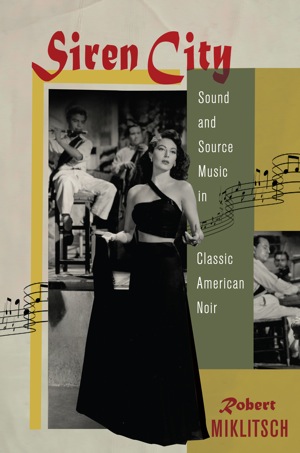Click here to print
Chasing Down the Film Noir
posted April 26, 2011
 In Siren City: Sound and Source Music in Classic American Noir (Rutgers University Press), Robert Miklitsch evidences a consuming passion for the form. And he achieves marvelous results, says Krin Gabbard, author of Hotter Than That: The Trumpet, Jazz, and American Culture: “Robert Miklitsch has convinced me. Sound and music in film noir are every bit as important as the visuals.”
In Siren City: Sound and Source Music in Classic American Noir (Rutgers University Press), Robert Miklitsch evidences a consuming passion for the form. And he achieves marvelous results, says Krin Gabbard, author of Hotter Than That: The Trumpet, Jazz, and American Culture: “Robert Miklitsch has convinced me. Sound and music in film noir are every bit as important as the visuals.”
Miklitsch, a film and media studies at Ohio University, and the editor of Psycho-Marxism and the author of From Hegel to Madonna: Towards a General Economy of “Commodity Fetishism” and Roll Over Adorno: Critical Theory, Popular Culture, Audiovisual Media, argues that dramatic expressionist visuals are not film noir’s only distinctive traits. He considers a wide range of films noirs, celebrated and not, and proposes the notion of audiovisuality to investigate period sound technologies such as the radio and jukebox, phonograph and Dictaphone, popular American music such as “hot” black jazz, and “big numbers” featuring iconic performers such as Lauren Bacall, Veronica Lake, and Rita Hayworth, as well as a palette of distinctive sounds – gunshots, sirens, swing riffs, canaries…
He contends that such elements have been given too little attention despite recent developments in studies of sound.
Here, Miklitsch muses about “The Chase” – his quest for films noirs.
I’ve been teaching a class on film noir, “Kiss Me Deadly: Classic and Neo-Noir,” at Ohio University for over 15 years, so I was very excited when I finally embarked on writing a book about the genre.
Siren City: Sound and Source Music in Classic American Noir confines itself to the 1940s, so the first issue for me was whether I would be able to view films from the period that were not available on DVD or, in some cases, VHS. (Seeing films in their original 35mm format was the exception, but a memorable event was watching Robert Siodmak’s wonderfully dolorous Christmas Holiday (1944) – at the height of the Christmas season no less – at the Wexner Center for the Arts located on the campus of The Ohio State University.)
In order to provide a “deep” or “thick” reading of 40s noir, I wanted to screen as many films from the period as possible, including and especially “B,” “obscure,” and/or “marginal” films such as Stuart Heisler’s Among the Living (1941) starring Albert Dekker as diametrically opposed brothers (one sane, one psychopathic); Arthur Ripley’s phantasmagorical, Cornell Woolrich-derived The Chase (1946); and Leslie Fenton’s Saigon (1948) starring that dynamic and iconic duo, Alan Ladd and Veronica Lake. (At this point, I hasten to add that “obscure” is a relative term; for some aficionados of the genre, noir is effectively defined not by “prestige” but “program” pictures: hence, the more obscure, the better.) My first resource for difficult-to-find films was a former undergraduate, then graduate student, Matt Gladman, a real film buff who over the years has compiled an extended library of titles from the 40s and 50s, including many noirs that were not available on DVD at the time I was writing. (A fount of noir trivia – man, am I glad I made Matt’s acquaintance!)
I then turned to other, obvious resources: the media library at Ohio University (a pretty good resource as we’ve had a School of Film for some time) and OhioLink (the electronic system that links all the college and university libraries in Ohio) as well as my local and city libraries. Although the Columbus Metropolitan Library was rated the best city library in the country in 2010 by the American Library Association, its noir holdings were, to my disappointment, limited; however, to my pleasant surprise, the Bexley Public Library possesses an excellent collection of classic noir DVDs. (When I inquired about this, I learned that one of the male librarians, who has since left to become a state trooper, was a fan of film noir.)
After exhausting what I took to be the usual suspects, I started searching on eBay for the noir titles I wasn’t able to locate via the above “venues.” I initially purchased DVDs from various sites, but the real find – a virtual treasure trove – was Bob Connors, who has amassed an astounding collection of Hollywood titles from the 1930s to the 1950s. If the bad news is that many were recorded from TV (with the usual poor visual or, more problematically for me, audio qualities), the very good news is that I was able to find virtually any and every film noir I had been searching for. Now, when I’m looking for a particular film (I’m currently writing a follow-up to Siren City), I just send Bob a list and it’s rare when he doesn’t have it. (Nota bene: at $4.00 per DVD plus mail, you can’t beat the price, although I always check out all the eBay purveyors on the chance I can access a VHS as opposed to TV-recorded copy.)
In the end, I managed to screen over 100 American film noirs from the 40s. While I was not able to write about each and every one, much as I wanted to (and such is my obsession with classic film noir, I very much wanted to), I felt confident in the belief that I possessed a thorough, working knowledge of the genre in its initial, classical phase. But I’d be lying if I claimed that that was the principal benefit, since the main thing for me was the sheer pleasure of watching and re-watching vintage noir. Still is.
Printed from Moving Image Archive News: https://www.movingimagearchivenews.org
URL to article: https://www.movingimagearchivenews.org/chasing-down-the-film-noir/
Click here to print